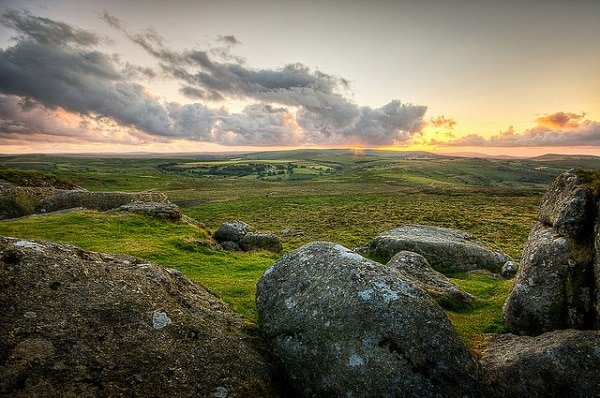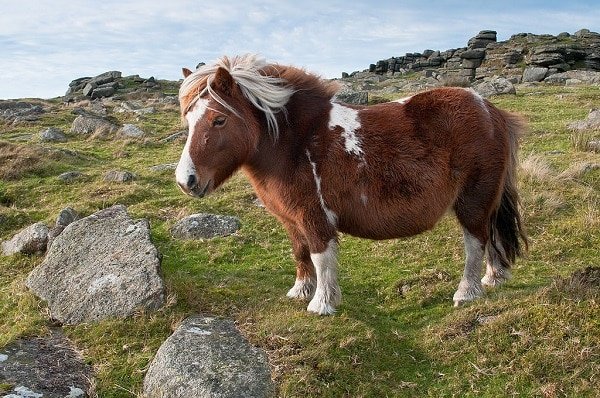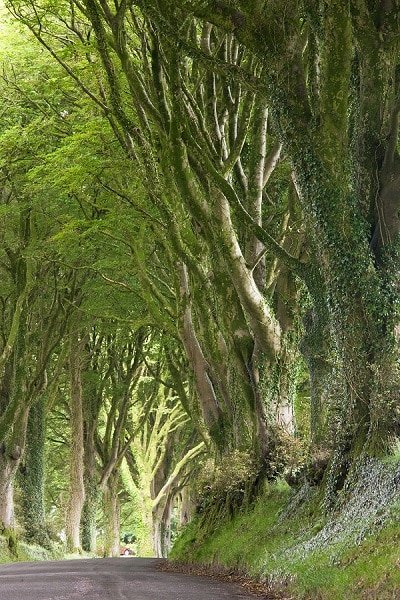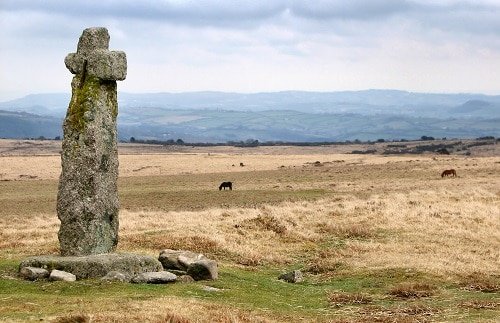
View across Hey Tor. By Herbythyme via Wikimedia Commons
In this weekly series, we’re looking at the National Parks of Great Britain. We’ll be showcasing some of the highlights, uncovering a few of those special places, and sharing tips on when to visit, where to stay, etc. In this week’s National Park Spotlight, we’re going to Devon to explore the wilds of Dartmoor.


The three visitor centres at Princetown, Postbridge, and Haytor are a great place to plan your trip, and pick up maps and souvenirs. The centre at Princetown also has a number of exhibitions and educational displays about the history of Dartmoor. In addition to the official visitor centres, there are information centres in a several local towns, including Buckfastleigh, Bovey Tracey, and Tavistock. For online information about activities, accommodation, and more, go to Visit Dartmoor.
What to do.
Dartmoor’s landscape is an expanse of moorland punctuated by tors, or exposed granite hilltops. The tors have long been a source of inspiration for artists and writers – The Hound of the Baskervilles, or more recently Harry Potter and the Goblet of Fire. To get a taste of the wilderness, enjoy some of the 450 miles of trails and pathways. Enjoy them by foot, bicycle, or on horseback. Trails range from easy to challenging, ensuring that there is something to suit everyone’s level of ability.
Those granite tors are also a haven for climbers. And in the winter, the park’s rivers are popular with canoeists. Or you could engage in the uniquely Dartmoor activity of Letterboxing. A precursor to modern geocaching (which Dartmoor is also great for), Letterboxing owes its origins to a man by the name of James Perrott from Chagford. In 1854, he set up the first Letterbox (actually a glass jar) near Cranmere Pool. Visitors to the area could leave little notes for future visitors to read. Now there are Letterboxes across the moor. Each one holds a visitors book for people to sign, and a rubber stamp. People can stamp their scrapbooks, diaries, etc, as a memento. The ambitious can attempt to collect all the Letterbox stamps.
The truly adventurous might want to sign up for a Bear Grylls Survival Camp. Three courses are available, from a 24-hour family-friendly option to a four day extreme challenge for adults. In each one, participants learn survival skills such as foraging, navigating, and building shelters.


What to see.
The stunning landscapes of Dartmoor have inspired countless myths of ghostly hauntings, big cats, and even visits from the Devil himself. It’s easy to see why. The isolated vistas with their rocky outcrops take on a mystical feel on a bleak wintry day.
Lydford Gorge is a National trust-owned property. It is worth a visit to see the gorgeous waterfalls. Another falls to visit is Becky Falls, an attraction sure to keep the children occupied with walks, Letterboxing, and a wildlife centre. Alternatively, visit England’s highest man-made waterfall at Canonteign Falls.
For historic buildings, Castle Drogo and Okehampton Castle have ruins to explore and restoration projects to study. They’re also great spots for a picnic. The beautiful Buckland Abbey was founded in 1278 and passed through the hands of several private owners, including Sir Francis Drake, after the Dissolution of the Monasteries. It has been cared for by the National Trust since 1948. Explore the house and grounds, and be sure to take home some mead or scrumpy.
Families with small children might like to visit Dingles Fairground Heritage Centre in Lifton. It’s an indoor attraction (so perfect if the weather turns) with hundreds of old fairground amusements and rides. Finally, for an outside fun ride, the South Devon Railway runs steam trains on a 7-mile track between Buckfastleigh and Totnes.

Avoid the crowds.
The visitor centres and attractions such as Becky Falls do attract crowds, especially at peak times and school holidays. However, if you get there early to do your planning, it shouldn’t be too difficult to then escape onto the moorland and enjoy the isolation.
Where to stay.
There are camp sites throughout the park. They range from family sites to smaller farm locations. Wild camping is also available in some spots. Motorhomes are increasingly common; however, they are not allowed on all roads. A good guide to campsites and other accommodations in the park is Enjoy Dartmoor, printed by the National Park Service.
Whatever your accommodation preference–hotel, bed and breakfast, rural farmhouse, or self-catering–you will find a huge range of options to suit a variety of budgets. Our sidebar includes several affiliate links to hotel chains and cottages within the area.




One thought on “National Park Spotlight: Dartmoor”
Comments are closed.